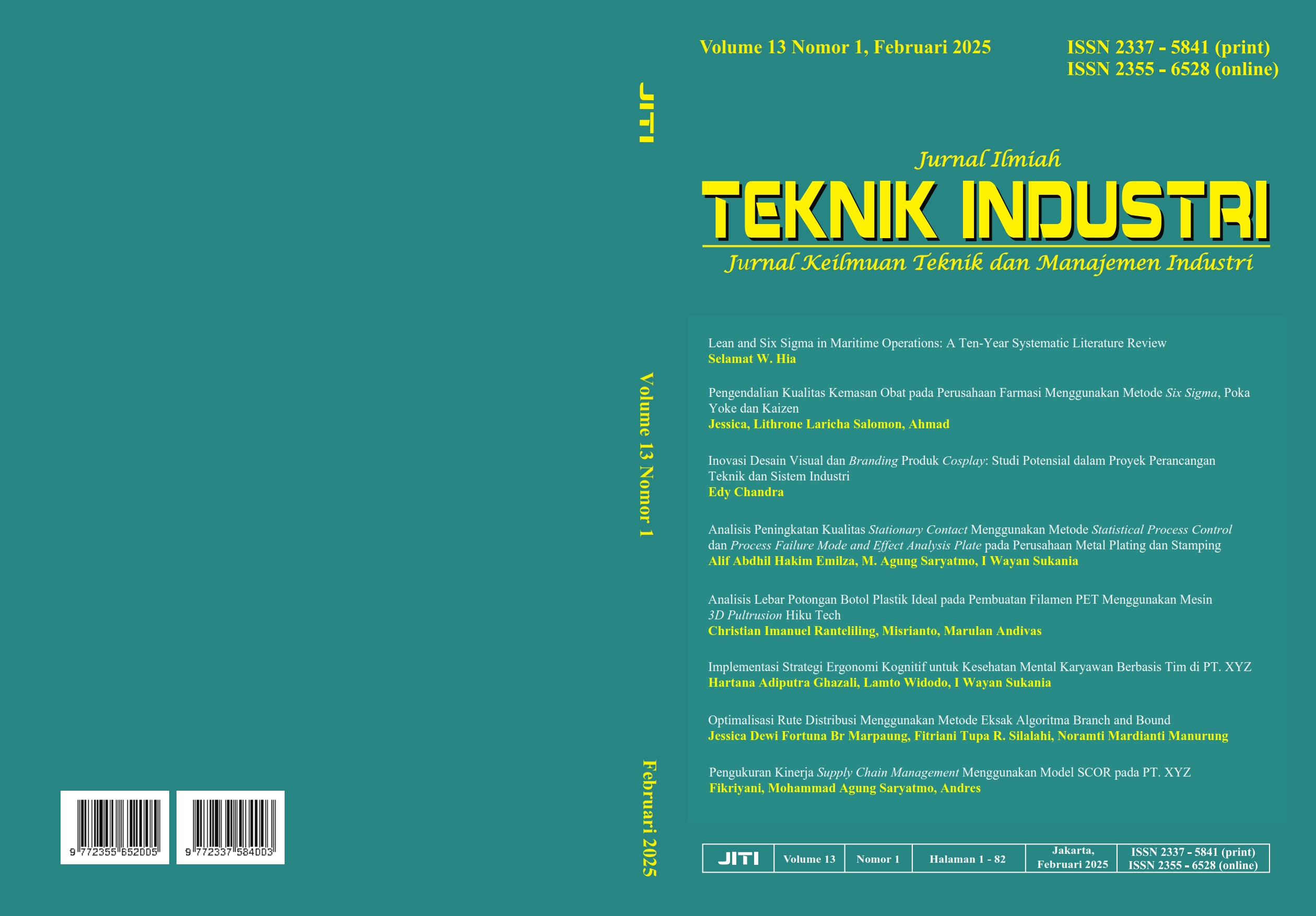ANALISIS PENINGKATAN KUALITAS STATIONARY CONTACT MENGGUNAKAN METODE STATISTICAL PROCESS CONTROL DAN PROCESS FAILURE MODE AND EFFECT ANALYSIS PLATE PADA PERUSAHAAN METAL PLATING DAN STAMPING
Isi Artikel Utama
Abstrak
The increasingly intense global competition demands that companies improve product quality in order to remain competitive in the market. At a metal plating and stamping company, a defect rate of 2.29% was identified, which exceeds the established standard by 0.29%. This study aims to identify the types of defects present in the company and their causes, with the goal of providing recommendations to improve production quality—specifically for the stationary contact plate product—using the Statistical Process Control (SPC) and Process Failure Mode and Effect Analysis (PFMEA) methods. Production and defect data were collected from January 2024 to March 2025 and implemented in April 2025 using checksheets, Laney P-charts, and Pareto diagrams to identify the types and frequency of defects. The results revealed three main types of defects: dented, bending, and scratch, with scratch being the most frequent. Further analysis using a fishbone diagram helped identify the root causes of the defects and prioritize corrective actions based on the Risk Priority Number (RPN). The proposed improvements include technical recommendations such as adding foam padding to the output container, reducing the distance between the stamping machine and the output container, and implementing a daily checksheet at the beginning of the production process.
Rincian Artikel

Artikel ini berlisensiCreative Commons Attribution-NonCommercial-ShareAlike 4.0 International License.

All publications by Jurnal Ilmiah Teknik Indsutri (Jurnal Keilmuan Teknik dan Manajemen Industri ) [p-ISSN: 2337-5841, e-ISSN: 2355-6528] is licensed under a Creative Commons Attribution-ShareAlike 4.0 International License.
Referensi
[1] O. Oktoberty, S. Suyanto, D.L. Mustikawati and A. Naufal, “Pelatihan Pelapisan Logam dengan Teknik Elektroplating,” Jurnal Pengabdian Dan Pemberdayaan Masyarakat, vol. 5, no. 1, pp. 69-77, 2025.
[2] I. Rahmatillah, S. Sundoro, and F. Lisye, “Peningkatan Kualitas Produk Crackers Berdasarkan Metode Lean Six Sigma di PT. M,” Jurnal Rekayasa Hijau, vol. 3, no. 2, pp. 95-106, 2019.
[3] K.P. Alifka and F. Apriliani, “Analisis Pengendalian Kualitas Produk Menggunakan Metode Statistical Process Control (SPC) dan Failure Mode and Effect Analysis (FMEA),” Jurnal Industri, Manajemen Dan Rekayasa Sistem Industri, vol. 2, no. 3, pp. 97-118, 2024.
[4] J. Susetyo, M. Yusuf and J. Geriot, “Pengendalian Kualitas Produk Gula Dengan Metode Statistical Processing Control (SPC) dan Failure Mode and Efect Analysis (FMEA),” Jurnal Teknologi, vol. 13, no. 2, pp. 127-135, 2020.
[5] A.R. Putri, K.N. Safitri and A.I. Alifido, “Pengendalian Kualitas Produk X menggunakan Pendekatan six Sigma,” Jurnal Teknik Ibnu Sina, vol. 9, no. 1, pp. 1-10, 2024.
[6] A.I. Deamonita and R.W. Damayanti, “Pengendalian Kualitas Tas Tali Batik di PT. XYZ dengan Menggunakan Metode Six Sigma,” Seminar Dan Konferensi Nasional Idec, 2018.
[7] Ubaidillah and I. Yuwono, “Analisis Defect Kualitas Produk Biji Plastik Menggunakan Metode Statistical Proses Control (SPC),” Jurnal Teknik Industri Terintegrasi, vol. 6, no. 3, pp. 533-544, 2023.
[8] R. Karuna, H.J. Kristina and I.W. Sukania, “Peningkatan Kualitas Dan Minimasi Waste Pada Produksi Kawat Tembaga Dengan Metode Lean Six Sigma,” Jurnal Mitra Teknik Industri, vol. 2, no. 3, pp. 241-253, 2023.
[9] M.R. Rosyidi, Pengendalian & Penjaminan Mutu, Malang: Ahlimedia Press, 2021.
[10] Mangindara, S. Rahmadani and S. Devi, Manajemen Jaminan Mutu Kesehatan, CV. Feniks Muda Sejahtera, 2022.
[11] S. Imam and D.M.N. Pakpahan, “Penggunaan FMEA dalam Mengidentifikasi Risiko Kegagalan pada Proses Produksi Kemasan Karton Lipat (Studi Kasus: PT. Interact Corpindo),” Journal Printing And Packaging Technology, vol. 1, no. 1, pp. 49-55, 2020.



